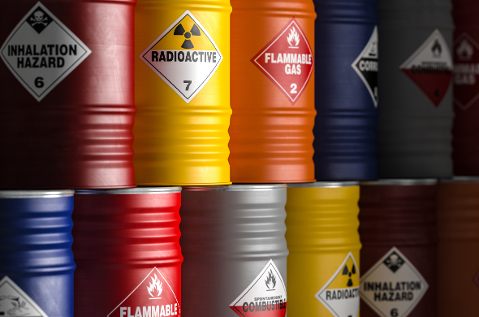The Occupational Safety and Health Administration (OSHA) is proposing several corrections to handrail and stair rail requirements it adopted in 2017 as part of major revisions to its Walking-Working Surfaces Standard (I wrote about those revisions HERE and HERE). The present proposal identifies several typographical errors and ambiguities in the 2017 revision, which OSHA states have led to confusion and questions from employers around the country. The proposal would create a transition period for employers that made plausible interpretations of the provisions to be corrected.
Read More
Tags:
OSHA,
handrail,
stair rail
Although the main focus of the Occupational Safety and Health Administration’s (OSHA’s) requirements, that employers protect workers against recognized ongoing hazards, associated with routine activities, employers’ responsibilities also extend to likely emergencies. Several OSHA standards address emergency conditions. These include emergency exit routes (which I wrote about HERE), emergency action plans (which I wrote about HERE), and fire prevention plans (FPPs). The remainder of this note discusses FPPs. Some OSHA standards require employers to create FPPs as part of their compliance programs. Even if your organization is not required by OSHA to do so, local fire codes or state requirements may apply. In every situation, you should consider the benefits of fire prevention and response activities.
Read More
Tags:
OSHA,
EAP,
FPP,
Fire Prevention
Since the 1980s, the Occupational Safety and Health Administration (OSHA) has required most employers to protect their workers from workplace chemical hazards, and to train workers to protect themselves. Most employers are subject to OSHA’s Hazard Communication Standard (HCS; 29 CFR 1910.1200), or to variants imposed by states delegated OSHA’s authority. OSHA revises its HCS from time to time; by far the biggest revisions were adopted in March 2012, when OSHA recast HCS to align it with the United Nations-sponsored Globally Harmonized System of Classification and Labeling of Chemicals (GHS). OSHA’s 2012 revisions conformed the US to GHS Revision 3, which was issued internationally in 2002. The most obvious change was the adoption of Safety Data Sheets (SDSs) to replace longstanding Material Safety Data Sheets (MSDSs), but employers faced a series of deadlines during 2013-2016.
Read More
Tags:
OSHA,
MSDS,
HCS,
GHS,
Hazard Communication
Many of President Biden’s immediate priorities relate to the federal government’s response to the COVID-19 pandemic. These include worker protection measures, which generally fall within the purview of the Occupational Safety and Health Administration (OSHA). Executive Order (EO) 13999 of January 21, 2021 (Executive Order on Protecting Worker Health and Safety) directs OSHA to rapidly enhance COVID-19 protection activities. The EO directed OSHA to update worker protection guidance to employers within two weeks, which OSHA met by publishing “Protecting Workers: Guidance on Mitigating and Preventing the Spread of COVID-19 in the Workplace,” which I discussed HERE.
Read More
Tags:
Health & Safety,
OSHA,
Coronavirus,
CDC,
Covid-19,
NEP,
NAICS
Regulators often rely on whistleblowers to reveal ongoing violations, and prosecutors rely on whistleblowers and informants from time to time to “make their cases.” Recognizing this value, many federal and state laws provide explicit protections for employees who report actual or potential violations to their employers or to the agencies that administer and enforce those laws.
The Occupational Safety and Health Administration (OSHA) has administered such a provision for workers disclosing violations of the Occupational Safety and Health Act for more than 40 years. In the intervening decades, a wide variety of federal statutes have expanded OSHA’s whistleblower protection activities, assigning OSHA to enforce whistleblower protection provisions of other laws; as of 2021 this authority covers 24 distinct federal laws. The best known and most litigated of these non-worker laws probably is the Sarbanes-Oxley Act of 2002 (SOx) – Section 806 of that law protects whistleblowers who report activities that may violate anti-fraud provisions of the federal Securities Acts. The rest of this posting identifies these laws, and summarizes how OSHA administers them.
Read More
Tags:
OSHA,
tsca,
Labour & Employment,
SDWA,
ACA,
ERA,
FSMA,
FRSA,
OSH Act,
AMLA,
AHERA,
CFPA,
CPSIA,
CAARA,
FWPCA,
ISCA,
NTSSA,
PSIA,
SPA,
STAA,
TFA
For nearly a year now, the Occupational Safety and Health Administration (OSHA) and other agencies have been issuing guidance to employers regarding COIVD-19, including identification, protection, and back-to-work procedures. One of incoming President Biden’s first Executive Orders (EO 13999 of January 21, 2021) directs OSHA to issue updated worker protection guidance to employers within two weeks. On January 29, OSHA met this requirement by publishing “Protecting Workers: Guidance on Mitigating and Preventing the Spread of COVID-19 in the Workplace,” which it explains is intended for employers and workers to use to identify risks and plan responses. The remainder of this note summarizes OSHA’s new guidance.
Read More
Tags:
Health & Safety,
OSHA,
EEOC,
Coronavirus,
CDC,
Covid-19
The US Occupational Safety and Health Administration (OSHA) requires employers to ensure workplace air quality, as part of the agency’s broad mission to protect workers’ safety and health. Instead of a single comprehensive standard, OSHA incorporates air-related issues into standards requiring employers to consider whether workplace conditions might require respiratory protections (which I discussed HERE), and additional standards addressing routine workplace air contaminants (which I discussed HERE), and special hazards of confined spaces (which I discussed HERE). OSHA also applies specific ventilation standards in workplaces that involve abrasive blasting; grinding, polishing, and buffing operations; and spray finishing operations.
Read More
Tags:
Health & Safety,
OSHA,
Coronavirus,
Covid-19
The Occupational Safety and Health Administration (OSHA) generally requires employers to ensure that employees (and other occupants of your workplace) have adequate and safe routes to leave work areas during fires and similar emergencies. OSHA presents these requirements in its Exit Routes Standard (29 CFR 1910.36 – 1910.37), with tie-ins to its emergency action plan and fire prevention plan standards (29 CFR 1910.38 and 1910.39). The following discussion summarizes the Exit Routes Standard.
Read More
Tags:
OSHA,
ADA,
Exit Routes Standard
During the COIVD-19 pandemic, there have been many reports of angry arguments between people who don’t want to wear masks or practice social distance and retail staff members trying to enforce local requirements. Some of these confrontations escalate to violence. The US Centers for Disease Control and Prevention (CDC) provide formal guidelines to retail businesses, offering ways for protecting workers by “Limiting Workplace Violence Associated with COVID-19 Prevention Policies in Retail and Services Businesses.” The remainder of this note describes CDC’s latest guidance.
Read More
Tags:
Health & Safety,
OSHA,
Workplace violence,
Coronavirus,
CDC,
Covid-19,
CCOHS
The federal Chemical Safety and Hazard Investigation Board – which usually refers to itself as the Chemical Safety Board or CSB -- has issued guidance on the hazards of explosive and combustible dust. The report is intended to identify the key barriers to improvement in the control and mitigation of combustible dust hazards. The report was developed by a contractor to CSB, after a fatal 2017 dust explosion at the Didion Milling facility in Cambria, Wisconsin. In October 2018, CSB issued a “Call to Action” to gather comments on the management, control and understanding of combustible dust (which I wrote about HERE). The objective of this project was to make sense of comments submitted in response to the Call to Action. CSB ultimately received 57 responses, which its contractor reviewed and supplemented with additional research.
Read More
Tags:
Health & Safety,
OSHA,
CSB,
chemical safety,
NFPA










